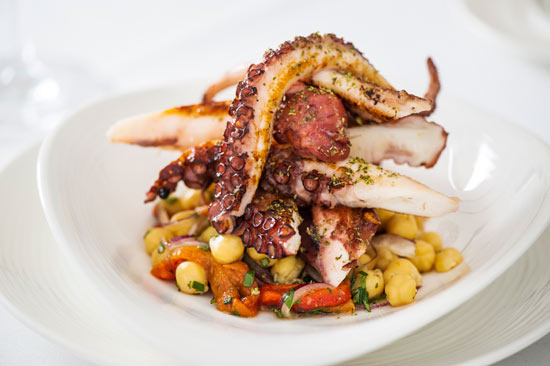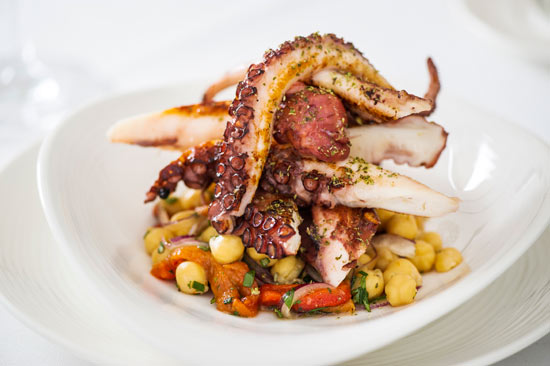Talking Greek: An Interview With Andreas Zinelis
Andreas Zinelis is the beverage director for Nerai, a modern Greek restaurant in New York City, which aims to create contemporary versions of traditional Greek cuisine. Zinelis, a Greek American born in Los Angeles, moved to Athens at age seven, where he lived for 10 years. Zinelis gained hospitality experience in Los Angeles, New York, and Greece. In Los Angeles, he worked with his father, who owned two Greek American restaurants. In New York, he worked at Harry's at Hanover Square, and enrolled in the French Culinary Institute.
"If I was going to work in hospitality, I wanted to learn as much as I possibly could," He explained.
In 2008, Zinelis moved back to Greece, where he and a cousin had a tiny Greek restaurant in the heart of Athens, cooking fresh food daily and pouring domestic wines from the Peloponnese. Ultimately, the financial crisis brought him back to New York, where he worked as a wine director for Kellari Hospitality, and a manager and sommelier at Buddakan.
His broad experience in hospitality, and his specific experience as a Greek American who lived and worked in Greece, has positioned Zinelis to be an important authority on Greek wines. His timing couldn't be better. The U.S. is the second most important market for Greek exports after Germany.
"The most important market for Greek wines in the U.S. is New York," said Sofia Perpera, a Bordeaux-trained oenologist and the director of the Greek Wine Bureau in North America "We calculated more than 480 restaurants and 520 wine shops selling Greek wines in the New York area in July 2013. Other important markets include Chicago, Texas, Florida, and San Francisco."
Since Nerai opened in May 2013, Zinelis has overseen a wine list of about 130 selections, 35 percent of which are Greek, along with Greek spirits and Greek-inspired cocktails. Half of the restaurant's wines by the glass are Greek, with three white, three red, and one rosé. The average cost of the wines by the glass at Nerai is $13 to $18.
Greek wines have increased in quality in the last decade, and they are typically sold at moderate price points. The zesty, high acid whites and the lighter bodied reds pair well with food. In addition, they offer a unique alternative to consumers looking to broaden their palates. But with more than 300 indigenous grape varieties and a host of international varieties, Greek wine lists can be difficult to navigate. Zinelis offers up some useful advice:[pullquote:left]
What tips would you offer guests on how to choose Greek wine?
Greek wine has come a long way from the Retsina days. Even Retsina is respectable right now. In the 80s and 90s, most people stayed away from Greek reds because of poor quality, high yields, and they weren't elegant. Not much complexity, very acidic. But the whites were always capable of standing out. They were more approachable. They had amazing geology and microclimates that helped the grapes succeed. Because Greece is so mountainous, flat areas were used for cultivating food. Anything left over, on the most obscure areas, like cliffs and so forth, was used for planting grapes. It was secondary. Santorini made a splash with the Assyrtiko grape, which you can compare to Sancerre. We also have Moschofilero, which is almost like a dry Muscat or an elegant Pinot grigio, based in the Peloponnese. For reds, there are two main varieties. Aghiorghitiko, based in Neméa and also known as St. George, comes in varying styles depending on altitude and producer, but generally speaking, I think of it like a Sangiovese. And, Xinomavro, which translates to "sour black" with a key area in Naoussa in Northern Greece, very cool climate, I often compare it to an Oregonian-style Pinot noir. Light body and lots of red fruit.
What about International Varietals?
Based on the indigenous varietals, Greek wines don't always hit certain flavor profiles. In some cases, the spectrum is limited. I find that international varietals help reach all sides of the spectrum. For instance, it's difficult to get a full-bodied red wine from an indigenous varietal. So one of our most full-bodied wines on our list is a Syrah, from Domaine Nerantzi, a biodymic producer. We are the only restaurant in New York City that pour it by the glass.
Why are you excited about Greek wines?
Quality has increased, a lot of people trained in France and Italy and came back and are doing amazing things with it. Most of the ingredients on our menu come from Greece, and the wines have developed to complement the food of the region. Greece offers a lot of crisp, light, fresh whites. Most of the Greek fare is light, and the reds run on the lighter side too, which complements the food. Some guests come to Nerai only wanting to taste Greek wines. That guest opens the door for an adventure.
Some wines fall into a category you call, "Ancient World" style?
When guests ask if a wine is New World or Old World, I find myself explaining it as Ancient World because it draws characteristics from both. Some of the wines are very fruit forward, with huge bouquets, but then again they have that dusty, terrior-driven essence to them so it's a combination of both worlds. I find it not only in Greek wines, but some of the Southern Italian wines from Sicily or Puglia, or even Lebanon. They are very unique.
How has the financial crisis affected Greek wines?
The Greek financial crisis has tightened up the market. The international market has helped the Greek wine market sustain itself. Within Greece, people drink table wine.
Producers are becoming more experimental, utilizing their land to the fullest extent. And like any growing wine region, people are realizing what is really working, and what's not. But there are a lot of areas and microclimates that need researching.
How do you see the future of Greek wine progressing?
A lot of the top restaurants have Greek wines on their list, because of the versatility and potential of the wines, and I wouldn't be surprised if, five to 10 years from now, a lot of small boutique producers could compete with the great wines. There are a couple producers right now in the southern part of Crete. We have a 1999 Domaine Economo. They have a white and a red, using indigenous Crete varietals. It's a movement we are living in. From 10 years ago, it's day and night. The whites have improved and the reds have come leaps and bounds.
What do you like to drink?
Besides enjoying Greek wines, I love St. Laurent from Austria, Pinot noirs from Russian River. I enjoy their elegance without overwhelming my palate. When I go out, Negronis, Manhattans, and single malts from Speyside are my go-to.
Zinelis offered tips on food and wine/spirits Pairing. He was kind enough to humor my sweet tooth, which inspired some intriguing and delectable dessert and spirits options.
Char-grilled Spanish octopus, served on chickpea salad with capers, red pepper, and onion.
A dry crisp wine like Assyrtiko would be great but a better pairing is a Zafeirakis Malagousia 2011 from a North Central area of Greece. It's got a little more body than the Assyrtiko, less angular, very rich with lemon and citrus notes. With the char it's outstanding. If the body of the wine isn't heavy enough, you might not appreciate the octopus as much, because octopus is fleshier.
Lavender mousse, a lavender infused yogurt with pineapple carpaccio, lavender honey and caramelized pecans.
Paired with: A chilled glass of Mastika
The mastic tree is a low growing shrub indigenous to the island of Chios, only in the Southern part of this island. It's an AOC of medieval villages. They make cuts along the bark. During the spring, sap raises and tears come out of the trunk. It's gummy, piney, and aromatic, almost like vanilla. The biggest tears are considered the highest quality, and they're used for distilled spirits, which is what Mastika is. The smaller ones are crystallized and used for baking, soap, bubblegum. With the lavender, the pairing would be excellent.
Saragliare hand-rolled baklava (wrapped all the way around as opposed to baklava cut into pieces) with almond and pistachio.
Paired with: Rakomelo
Rakomelo is Greek grappa infused with cinnamon and honey. It doesn't have the jet propulsion alcohol levels of other grappa, it comes in around 24 percent. The cinnamon and honey already baked into the baklava would be a nice marriage. It's very popular on the island of Crete. It's served warm in the winter, otherwise room temperature.
Additional featured wines at Nerai:
Domaine Nerantzi Syrah, Serres, 2008. With only 1800 bottles produced annually, it's not readily available elsewhere. This wine fits Zinelis' "Ancient World Style," an aromatic blend of ripe fruit and earthiness. Elegant and balanced.
Domaine Skouras Moschofilero, Salto, 2012. A sophisticated example of this grape variety, with citrus, floral notes, salinity, and a little desirable funk from the wild yeast fermentation.

